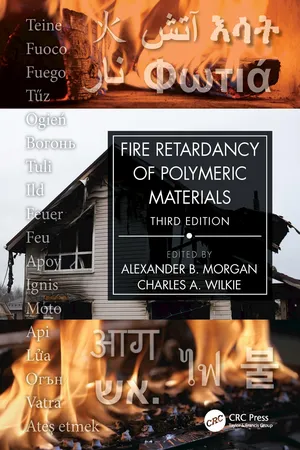
Fire Retardancy of Polymeric Materials
- 776 pages
- English
- ePUB (mobile friendly)
- Only available on web
Fire Retardancy of Polymeric Materials
About This Book
The third edition of Fire Retardancy of Polymeric Materials provides a single source for all aspects of this highly challenging field of applied research. This authoritative book covers design and non-fire requirements that drive how these materials are fire protected.
Detailed study and consideration of chemistry, physics, materials science, economic issues and fire safety science is necessary to address considerations of mechanical, thermal, environmental, and end-use requirements on top of fire protection means that the field requires. This thoroughly revised new edition continues to offer comprehensive coverage of the scientific approach for those developing fire safe materials. It covers new topics such as bio-based materials, regulatory issues, recycling, newer flame retardant chemical classes, and more details on how to flame retard materials for specific market applications.
Written by a team of experts, this book covers the fundamentals of polymer burning and combustion and how to apply fire protection or flame-retardant chemistries to specific material classes and applications. The book is written for material scientists and fire safety scientists who seek to develop new fire safe materials or understand why materials burn in our modern environment.
Features
- Connects fundamentals of material flammability to practical fire safety needs
- Covers current fire safety requirements and regulations affecting flame retardant selection
- Provides information on chemical structure-property relationships for flame retardancy
- Provides practical guidance on how to design fire safe materials for specific fire risk scenarios
- The new edition is expanded to 32 chapters and all chapters are updated and revised with the newest information
Frequently asked questions
Table of contents
- Cover
- Half Title
- Title
- Copyright
- Contents
- Preface
- List of Contributors
- Chapter 1 An Introduction to Materials Flame Retardancy and Fire Protection
- Chapter 2 Thermal Decomposition of Flame Retardant Polymers
- Chapter 3 Physical Parameters Affecting Fire Growth
- Chapter 4 Halogen-Containing Flame Retardants
- Chapter 5 Phosphorus-Containing Flame Retardants
- Chapter 6 Flame Retardant Fillers
- Chapter 7 Intumescence-Based Flame Retardant
- Chapter 8 Silicon and Inorganic Flame Retardants
- Chapter 9 Boron-Based Flame Retardants
- Chapter 10 Nitrogen-Based Flame Retardants
- Chapter 11 Non-Halogen Radical Generators for Enhanced Flame Retardancy of Plastics
- Chapter 12 Polymer Nanocomposites
- Chapter 13 Bio-Based Flame Retardants
- Chapter 14 Conformal Flame Retardant Coating Systems
- Chapter 15 Flame Retardants without Conventional Flame-Retardant Elements
- Chapter 16 Multi-Component Flame-Retardant Systems
- Chapter 17 Uses of Fire Tests for Flame-Retardant Material Development
- Chapter 18 Material Flammability Measurements and Test Methods
- Chapter 19 Fire Emissions and Smoke Toxicity
- Chapter 20 Toward a Quantitative Relation between the Molecular Structure and Fire Growth on Polymeric Solids
- Chapter 21 Full-Scale Fire Modeling and Simulation
- Chapter 22 Regulations, Codes, and Standards Relevant to Fire Issues in the United States
- Chapter 23 Chemical Regulation of Flame Retardants
- Chapter 24 Recycling of Flame-Retardant Polymeric Materials: State of the Art and Future Perspectives
- Chapter 25 Flame-Retardant Design and Protection for Fiber-Reinforced Composites
- Chapter 26 Flame-Retardant Design and Protection for Wood and Wood Products
- Chapter 27 Flame-Retardant Design and Protection for Textiles
- Chapter 28 Flame-Retardant Design and Protection for Electrical and Electronic Systems
- Chapter 29 Flame-Retardant Design and Protection for Wire and Cable
- Chapter 30 Flame-Retardant Design and Protection for Building Materials
- Chapter 31 Flame-Retardant Design and Protection for Furniture and Furnishings
- Chapter 32 The Future of Material Fire Protection—Unmet Needs, New Fire Risk Scenarios, and New Flame Retardant Approaches
- Index